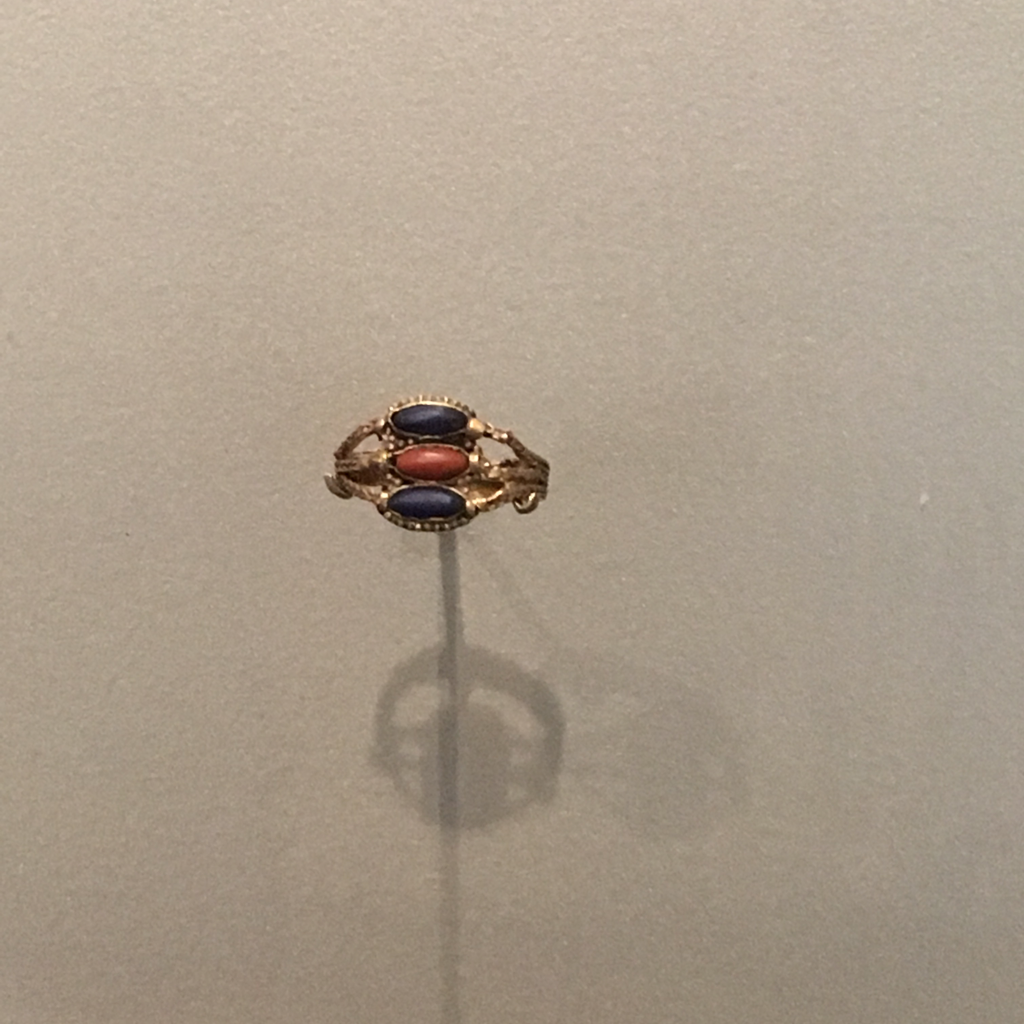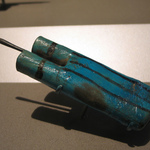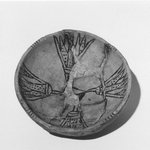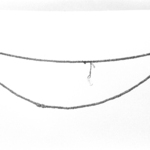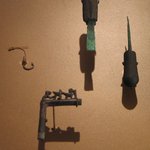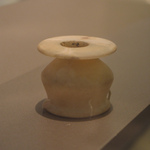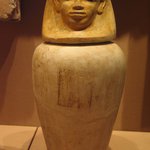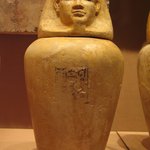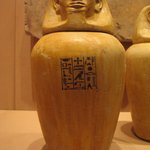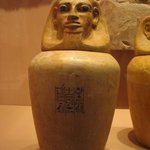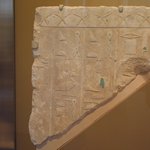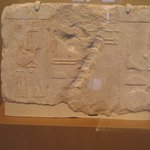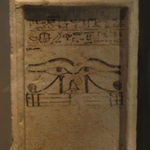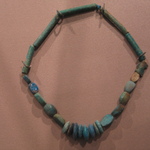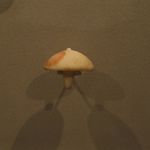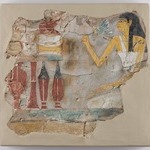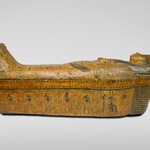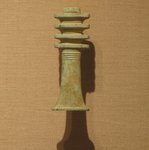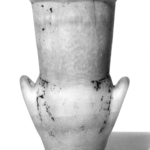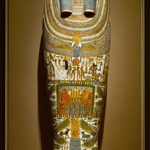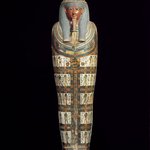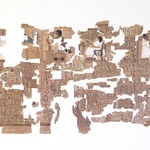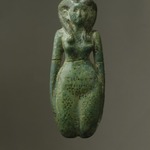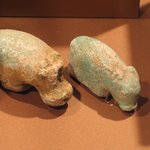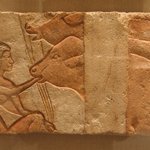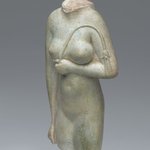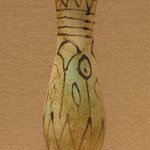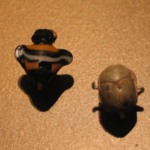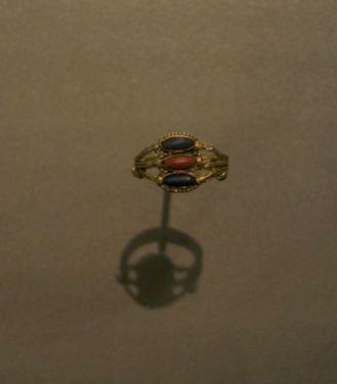
Ring with Inlays
Egyptian, Classical, Ancient Near Eastern Art
On View: Egyptian Orientation Gallery, 3rd Floor
Rings
The earliest Egyptian rings were purely decorative, but later rings came to carry significance.
By the Eighteenth Dynasty of the New Kingdom, they were frequently inscribed with the name of a god, a king, or the owner. The most popular type was made of faience and bore the name of the reigning monarch. Archaeologists have discovered thousands of these simple, mold-made rings; they were probably distributed as mementos at religious or state celebrations. Other rings feature protective symbols, including the wedjat-eye. Wealthy members of Eighteenth Dynasty society often wore rings made of inlaid glass or semiprecious stones.
The earliest Egyptian rings were purely decorative, but later rings came to carry significance.
By the Eighteenth Dynasty of the New Kingdom, they were frequently inscribed with the name of a god, a king, or the owner. The most popular type was made of faience and bore the name of the reigning monarch. Archaeologists have discovered thousands of these simple, mold-made rings; they were probably distributed as mementos at religious or state celebrations. Other rings feature protective symbols, including the wedjat-eye. Wealthy members of Eighteenth Dynasty society often wore rings made of inlaid glass or semiprecious stones.
MEDIUM
Electrum, glass
DATES
ca. 1479–1292 B.C.E.
DYNASTY
Dynasty 18
PERIOD
New Kingdom
DIMENSIONS
1 3/8 x 13/16 x 1/2 in. (3.6 x 2 x 1.3 cm) (show scale)



COLLECTIONS
Egyptian, Classical, Ancient Near Eastern Art
ACCESSION NUMBER
37.719E
CREDIT LINE
Charles Edwin Wilbour Fund
CATALOGUE DESCRIPTION
Electrum and glass finger ring. The shank is a strip of gold to which six pairs of twisted wires are soldered to form a braided ornament. At the shoulder the shank spreads into three narrower strips. The split shoulders are soldered to the bezel and the joints are covered by narrow pieces of the electrum sheet bent into cylindrical sleeves. The bezel consists of a bottom plate to which strips of electrum are soldered on edge to form cells for inlays; it is further embellished with granulation. The inlays are of red and blue glass in imitation of carnelian and lapis lazuli.
Condition: Ancient repairs: shank once broken in two and soldered together; where the braid ornament had split open, the loose end was fastened to the underplate by soldering on a rectangular patch. Two short sections of ornament are missing from the shank and a few grains are lost from the bezel. Hole in the bottom plate of the bezel.
EXHIBITIONS
MUSEUM LOCATION
This item is on view in Egyptian Orientation Gallery, 3rd Floor
CAPTION
Ring with Inlays, ca. 1479–1292 B.C.E. Electrum, glass, 1 3/8 x 13/16 x 1/2 in. (3.6 x 2 x 1.3 cm). Brooklyn Museum, Charles Edwin Wilbour Fund, 37.719E. Creative Commons-BY (Photo: Brooklyn Museum, CUR.37.719E_erg456.jpg)
IMAGE
overall, CUR.37.719E_erg456.jpg. Brooklyn Museum photograph, 9/6/2007
"CUR" at the beginning of an image file name means that the image was created by a curatorial staff member. These study images may be digital point-and-shoot photographs, when we don\'t yet have high-quality studio photography, or they may be scans of older negatives, slides, or photographic prints, providing historical documentation of the object.
RIGHTS STATEMENT
Creative Commons-BY
You may download and use Brooklyn Museum images of this three-dimensional work in accordance with a Creative Commons license. Fair use, as understood under the United States Copyright Act, may also apply.
Please include caption information from this page and credit the Brooklyn Museum. If you need a high resolution file, please fill out our online application form (charges apply).
For further information about copyright, we recommend resources at the United States Library of Congress, Cornell University, Copyright and Cultural Institutions: Guidelines for U.S. Libraries, Archives, and Museums, and Copyright Watch.
For more information about the Museum's rights project, including how rights types are assigned, please see our blog posts on copyright.
If you have any information regarding this work and rights to it, please contact copyright@brooklynmuseum.org.
RECORD COMPLETENESS
Not every record you will find here is complete. More information is available for some works than for others, and some entries have been updated more recently. Records are frequently reviewed and revised, and we welcome any additional information you might have.



